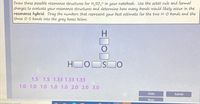
Chemistry
10th Edition
ISBN: 9781305957404
Author: Steven S. Zumdahl, Susan A. Zumdahl, Donald J. DeCoste
Publisher: Cengage Learning
expand_more
expand_more
format_list_bulleted
Concept explainers
Question

Transcribed Image Text:Draw three possible resonance structures for H,SO, in your notebook. Use the octet rule and formal
charges to evaluate your resonance structures and determine how many bonds would likely occur in the
resonance hybrid. Drag the numbers that represent your best estimate for the two H-O bonds and the
three 0-S bonds into the gray boxes below.
H
HI
ISO
1.5 1.5 1.33 1.33 1.33
1.0 1.0 1.0 1.0 1.0 2.0 2.0 3.0
Undo
Submit
Reset
Expert Solution
This question has been solved!
Explore an expertly crafted, step-by-step solution for a thorough understanding of key concepts.
This is a popular solution
Trending nowThis is a popular solution!
Step by stepSolved in 2 steps with 1 images

Knowledge Booster
Learn more about
Need a deep-dive on the concept behind this application? Look no further. Learn more about this topic, chemistry and related others by exploring similar questions and additional content below.Similar questions
- Answer the following questions about the Lewis structure for calcium hydrogen carbonate, Ca(HCO3)2 There are calcium ions and hydrogen carbonate ions. There are ionic bonds in the molecule. The calcium ion has electron dots. Each hydrogen carbonate ion has central atoms and valence electrons. Each hydrogen carbonate ion has single covalent bonds, double covalent bonds, and triple covalent bonds. In each hydrogen carbonate ion, the central C has REDS, the shape is y and the bond angles are about In each hydrogen carbonate ion, the central O has REDS and the shape is а. О b. 1 С. 2 d. 3 е. 4 f. 5 g. 8 h. 10 i. 12 j. 14 k. 16 I. 18 m. 20 n. 24 О. 26 р. 30 q. 32 r. 34 S. 36 t. diatomic u. pyramidal v. linear z. bent y. trigonal planar w. monoatomic ions x. tetrahedral aа. 1200 bb. 180° Cc. no bond angles, no central atom nonpolar dd. 109.5° ее. polar ff. gg. ionic hh. O and Oarrow_forwardCan you help me with the OF2 step-by-step for number (Step 6)? I need help with the central atom surrounded by an identical electron group. I need help with the molecule polar.arrow_forward+] QUESTION 20 Which is true regarding the H-F bond in the compound HF it is ionic O it is polar covalent it is nonpolar covalent none of the above QUESTION 21 Explain your reasoning for the previous problem For the toolbar, press ALT+F10 (PC) or ALT+FN+F10 (Mac). Paragraph Arial 10pt Because Hydrogen fluoride is a gas and doesn't form a solids ionic compounds. P. Click Save and Submit to save and submit. Click Save All Answers to save all answers. M.arrow_forward
- BC3 Draw the molecule by placing atoms on the grid and connecting them with bonds. Include all lone pairs of electrons and nonbonding electrons. To change the symbol of an atom, double-click on the atom and enter the letter of the new atom. An H N F Br X Morearrow_forwardUse the molecular model kit to construct the following models, and then fill in the boxes for each molecule. When possible. show a resonance Lewis structure. Use formal charge, when possible to select the best structure. Follow example for CH4 below. Formula #VES Lewis Structure H CH4 8 H C H -I H Resonance? (Y/N) Show N Electron Group & Bond Angle Tetrahedral 109° Molecular Geometry Polar? (Y/N) tetrahedral N VSPER Sketch H 1 H 109.5° H H Hybridization sp³arrow_forwardNumber of lone pairs of electrons associated with central atom (LP) +Lewis Structure Diagram Number of electron groups associated with the central atom (EG) Geometric arrangement (GA) Molecular shape (MS) Bond angle(s) Overall dipole (yes/no if yes, include below) 3D drawing XeF4 PC15 SO₂arrow_forward
- Draw the best Lewis Structure for N2O2 based on overall formal charges. The skeleton framework for N2O2 is: O—N—N—O. Answer the questions below based on your final structure. How many (total) bonding electron pairs are on the two oxygen atoms (total for both)? ______ How many (total) non-bonding electron pairs are in the whole molecule?______ How many electron pairs are shared between the nitrogen atoms? ________arrow_forwardCan someone please fill the boxes?arrow_forward
arrow_back_ios
arrow_forward_ios
Recommended textbooks for you
 ChemistryChemistryISBN:9781305957404Author:Steven S. Zumdahl, Susan A. Zumdahl, Donald J. DeCostePublisher:Cengage Learning
ChemistryChemistryISBN:9781305957404Author:Steven S. Zumdahl, Susan A. Zumdahl, Donald J. DeCostePublisher:Cengage Learning ChemistryChemistryISBN:9781259911156Author:Raymond Chang Dr., Jason Overby ProfessorPublisher:McGraw-Hill Education
ChemistryChemistryISBN:9781259911156Author:Raymond Chang Dr., Jason Overby ProfessorPublisher:McGraw-Hill Education Principles of Instrumental AnalysisChemistryISBN:9781305577213Author:Douglas A. Skoog, F. James Holler, Stanley R. CrouchPublisher:Cengage Learning
Principles of Instrumental AnalysisChemistryISBN:9781305577213Author:Douglas A. Skoog, F. James Holler, Stanley R. CrouchPublisher:Cengage Learning Organic ChemistryChemistryISBN:9780078021558Author:Janice Gorzynski Smith Dr.Publisher:McGraw-Hill Education
Organic ChemistryChemistryISBN:9780078021558Author:Janice Gorzynski Smith Dr.Publisher:McGraw-Hill Education Chemistry: Principles and ReactionsChemistryISBN:9781305079373Author:William L. Masterton, Cecile N. HurleyPublisher:Cengage Learning
Chemistry: Principles and ReactionsChemistryISBN:9781305079373Author:William L. Masterton, Cecile N. HurleyPublisher:Cengage Learning Elementary Principles of Chemical Processes, Bind...ChemistryISBN:9781118431221Author:Richard M. Felder, Ronald W. Rousseau, Lisa G. BullardPublisher:WILEY
Elementary Principles of Chemical Processes, Bind...ChemistryISBN:9781118431221Author:Richard M. Felder, Ronald W. Rousseau, Lisa G. BullardPublisher:WILEY

Chemistry
Chemistry
ISBN:9781305957404
Author:Steven S. Zumdahl, Susan A. Zumdahl, Donald J. DeCoste
Publisher:Cengage Learning

Chemistry
Chemistry
ISBN:9781259911156
Author:Raymond Chang Dr., Jason Overby Professor
Publisher:McGraw-Hill Education

Principles of Instrumental Analysis
Chemistry
ISBN:9781305577213
Author:Douglas A. Skoog, F. James Holler, Stanley R. Crouch
Publisher:Cengage Learning

Organic Chemistry
Chemistry
ISBN:9780078021558
Author:Janice Gorzynski Smith Dr.
Publisher:McGraw-Hill Education

Chemistry: Principles and Reactions
Chemistry
ISBN:9781305079373
Author:William L. Masterton, Cecile N. Hurley
Publisher:Cengage Learning

Elementary Principles of Chemical Processes, Bind...
Chemistry
ISBN:9781118431221
Author:Richard M. Felder, Ronald W. Rousseau, Lisa G. Bullard
Publisher:WILEY